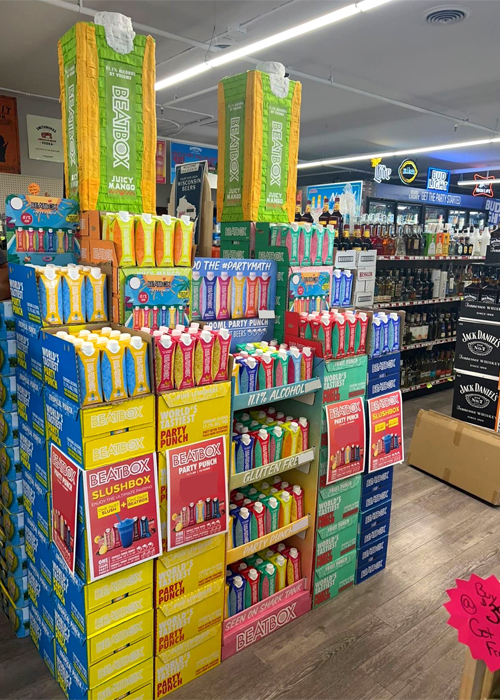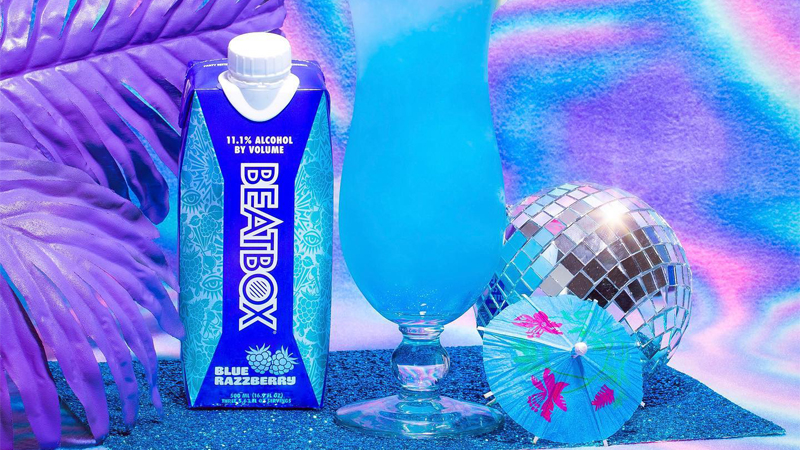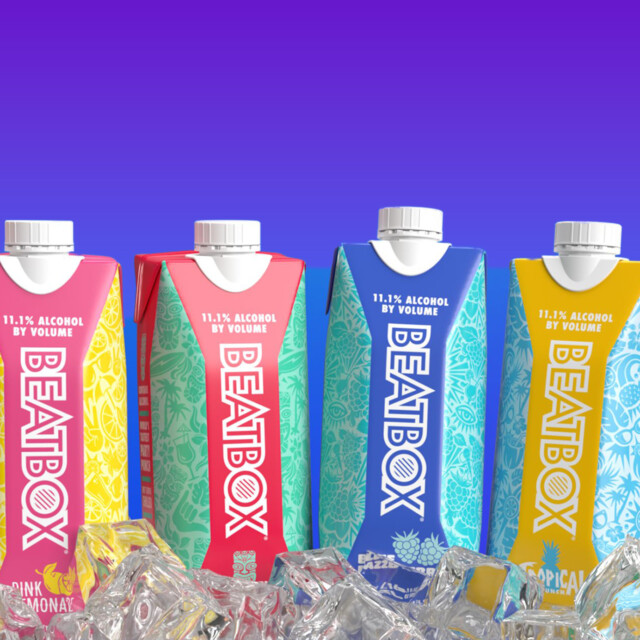Certain products catch fire by filling a very specific niche, and matching the desires and preferences of a narrow set of consumers. In other instances, a throw-it-on-the-wall-and-see-if-it-sticks approach is taken. Take BeatBox, a wine-based RTD that shipped 380,000 cases in 2020, 850,000 in 2021, and is on track for about 1.8 million in 2022.
If you have a box that needs to be checked off, the brand will do its best to check it for you, with an amorphous, we’re-everything-for-everyone, buzzword-laden philosophy. Want to get lit? BeatBox’s 11 percent ABV offering is equal to four light beers — it’s called #partymath, brah. Prefer the low-cal life? The 6 percent offering delivers under 100 calories per serving. If you’re gluten-free, vegan, or trying to cut down on sugar, they got you. Eco-free shipping and packaging, with recycling and resealing capabilities? Say hello to Tetra Pak. Check, check, check, and check.
To the industry, BeatBox is the “No. 1 fastest-selling ready-to-drink cocktail & wine brand in the U.S.” To the consumer, it’s “the world’s tastiest party punch.” As for the brand? “We used to say that we’re the leaders in the party punch category,” says co-founder and CEO Justin Fenchel, “even though we were the only ones in the party punch category.”
It’s been a unique journey of success. Neon-tinged, saved-by-the-bell-era nostalgic imagery, combined with the music festival circuit, a very particular means of production, and a few key boosts along the way, have enabled BeatBox to crowd beer stores’ shelves the way the summer’s latest big pop hit inundates the airwaves of top radio stations.
RTDs Rising — but Made With Wine?
It’s no secret that RTDs are as hot as Kelly Kapowski circa 1992. According to the Distilled Spirits Council of the United States, they’re the fastest-rising spirits category, growing 55.9 percent by volume in 2021 by adding 13.1 million 9-liter cases in sales. The organization expects RTDs to represent as much as 25 percent of total alcohol sales by 2024.
According to IWSR Drinks Market Analysis, meanwhile, RTDs overtook spirits and wine in 2021 to become the second-largest alcohol category by volume in the U.S., behind only beer. Future growth is projected at an 11 percent CAGR clip from 2021 to 2026. It’s worth noting here that the category as tracked by IWSR includes hard seltzers and flavored malt beverages, spirits-based cocktails, and everything from hard tea and wine coolers to hard kombucha and hard coffee.
Overall, though, 91 percent of RTDs are malt-based, 8 percent are spirits-based, and 1 percent are wine-based, according to DISCUS. BeatBox falls into that wine-based segment, but when you open one up and pour either a clear, seltzer-like beverage (the 6 percent) or a Gatorade-hued one (the 11 percent), the connection to wine might be a bit confusing. Welcome to the world of Other Than Standard, or OTS, wine.

Google “what is other than standard wine?” and you might even pull up an obscure Reddit thread with users asking about — guess what? — BeatBox. The OTS category includes a grab bag of fermented odds and ends that don’t neatly fit into other approved and regulated forms of alcohol production. The reason a brand might want to make a product from something such as OTS wine comes down to one simple thing: taxes. The federal excise tax for spirits is $13.50 per proof gallon, but just $1.07 per gallon of wine up to 16 percent ABV, and then $1.57 per gallon above that. The state level typically sees similar tax discrepancies added on top. Meanwhile, as opposed to a malt base, OTS wine can be jacked up to 21 percent ABV while retaining its categorization, without the introduction of spirits. Instead, you take something such as orange peels or grape skins and add plenty of sugar to drive that alcohol percentage up during fermentation. BeatBox confirms it uses “fermented orange peels that get up to 21 percent ABV neutral wine.”
So when you see “orange wine” as the chief ingredient on a Tetra Pak of BeatBox, it’s not the orange wine found in your favorite hipster-friendly natural wine bar in Williamsburg. “Yeah, I mean, without getting too much into the trade secrets or anything, we use the bulk OTS wine, which is like a 21 percent alcohol base, a neutral base, a clean base,” Fenchel says. “It’s that, water, our flavoring, and we use a little bit of cane sugar and a little bit of Splenda.” Party punch! It’s fruit residue and sugar transmogrified into that booze fix you so clearly crave, and it’s a dead ringer for Dave Chapelle’s famed grape drink bit from the 2000s. Instead of “sugar, water, purple,” it’s sugar, water, orange peels. And in this case, the orange drink received an early $1 million infusion from Mark Cuban on “Shark Tank,” a more recent $2.2 million across two WeFunder rounds, and can be found in 36,000 shops across the country and counting.
How BeatBox Skyrocketed to Success
While BeatBox’s ingredients and production may seem a bit convoluted or mysterious, none of this is necessarily a problem, especially when pitted against the rest of the vague RTD and seltzer category. It’s just another piece of the BeatBox jigsaw puzzle. In fact, figuring out how to put those pieces together in terms of defining and selling a product that’s legally classified as wine-based to consumers who want seltzers — and stores that want to stock seltzers — was the game-changing moment for the brand.
Fenchel co-founded the brand along with a handful of his classmates from the McCombs School of Business at the University of Texas at Austin, with an early iteration of the drink appearing on store shelves in 2013. They weren’t just a cohort of MBA students, they were a collective of music festival buddies, and that spirit was infused into BeatBox’s ethos.
“When we created the brand we said if you could capture the essence of a music festival, the world would have a f*cking ton less problems,” Fenchel says. “That was in our DNA.”
By 2014, “Shark Tank” came calling, with the Cubes proffering a seven-figure investment for the brand. Still, BeatBox had a relatively prodding start in its early years, experimenting with its sizes, packaging, and messaging, among other fine-tuning. The big move came when BeatBox switched its distribution network, moving away from wine and spirits wholesalers to beer distributors. Fenchel says they first made the shift in Georgia, where in 2016 and 2017 combined they sold 900 cases; after switching, they sold 20,000 cases in 2018. Voila. Wine-based, schmine-based, this is party punch. “We happen to be wine-based, but we don’t lead with that,” Fenchel says. “That’s when things really started to click with us. Like holy sh*t, we have something that’s totally different.”
Still, BeatBox had to tackle the issue of being wine-based while being sold to the beer and FMB [flavored malt beverages] world. “Because of our base, we are right away taken to the wine buyer,” Fenchel says. “And they also control the warm shelves, and hey, nobody is shopping the warm wine aisle for Blue Raspberry. And so we have to fight that fight.”
There’s more to BeatBox’s secret sauce than that. While its eco-friendly Tetra Pak may be one of those checkboxes we riffed on, the interest in, and benefits of, supporting such products are legitimate. “We’re witnessing a cultural shift, normalizing the consumption of alcohol drinks in cartons,” says Manuel Calderon, the vice president of packaging portfolio management for Tetra Pak. And the across-the-board benefits of cartons versus plastic or glass bottles are vast and supported by loads of verified research. “In particular, plastic continues to be an issue for consumers, with 42 percent saying they are consciously using less since the pandemic.”
Then there are the music tie-ins, which for BeatBox provide much more than a name. That music festival feeling of freedom and fun is what the brand strives to create. It’s not just a vibe though, it’s a pound-the-pavement approach that gives it access to a huge swath of consumers. “We are going to do over 100 music festivals and events this year,” Fenchel says. “So we are connecting with hundreds of thousands or millions of consumers at these experiences, and they are going home — and I cannot even tell you the amount of engagement inbound from social media.”
How do you relive that killer music festival you had the time of your life at? Doing it all over again at home. “People are posting, you know, ‘I’m reliving EDC [Electric Daisy Carnival] with my friends’ and they’re like watching videos, drinking a BeatBox,” Fenchel says. “It’s so authentic and real. That’s the biggest thing for us.”

Therefore, BeatBox hasn’t needed the marketing oomph that an ABI or Boston Beer-backed RTD brand wields. Instead, BeatBox capitalizes on the full power of the 2022 digital sphere: influencers, Discord communities, and hashtags galore, rooted largely in music and music festivals. And the people who find its products there also become advocates as a result.
If it’s about the music and the vibes and the fun, maybe it doesn’t matter what it is and what it’s made from at all. “Consumers don’t necessarily care too much about the base, they care that it tastes great,” Fenchel says with a laugh.
While there are a lot of bells and whistles, and yes, checkboxes, a huge component of BeatBox capturing a slice of the zeitgeist is based on fundamental consumer research. If you think about those good ol’ four Ps of marketing you might remember from some introductory course or another — product, price, place, and promotion — music festivals are promotion and the brand’s distributor shift takes care of place, leaving product and price. “The three biggest things I talk about: the taste, the price, and the alcohol content,” Fenchel says. “We check all those boxes [see, they love checking boxes!], and I am constantly amazed that some of our larger competitors, with how much money they have to throw at these things, miss on multiple of those fronts.”
And as for the taste, if you sample through a multi-flavor pack of BeatBox, you may find your own childhood “grape drink” style comparison — and, well, that’s very much the idea, too. “Blue Raspberry; we all grew up drinking blue Gatorade,” Fenchel says. “And Fruit Punch, right? It tastes like that classic Hawaiian Punch with the surfer dude on it.”
While BeatBox is running roughshod among most of its wine-based counterparts, the brand is still a drop in the RTD bucket. White Claw, for instance, sold 58.5 million cases in 2020. But make no mistake about it, it’s coming to a music festival, and then a big-box beer store, near you. “[W]hat Bud Light is to football, BeatBox is to music, and there should never be a party without music, so there should never be a party without BeatBox,” Fenchel says.
This story is a part of VP Pro, our free platform and newsletter for drinks industry professionals, covering wine, beer, liquor, and beyond. Sign up for VP Pro now!
